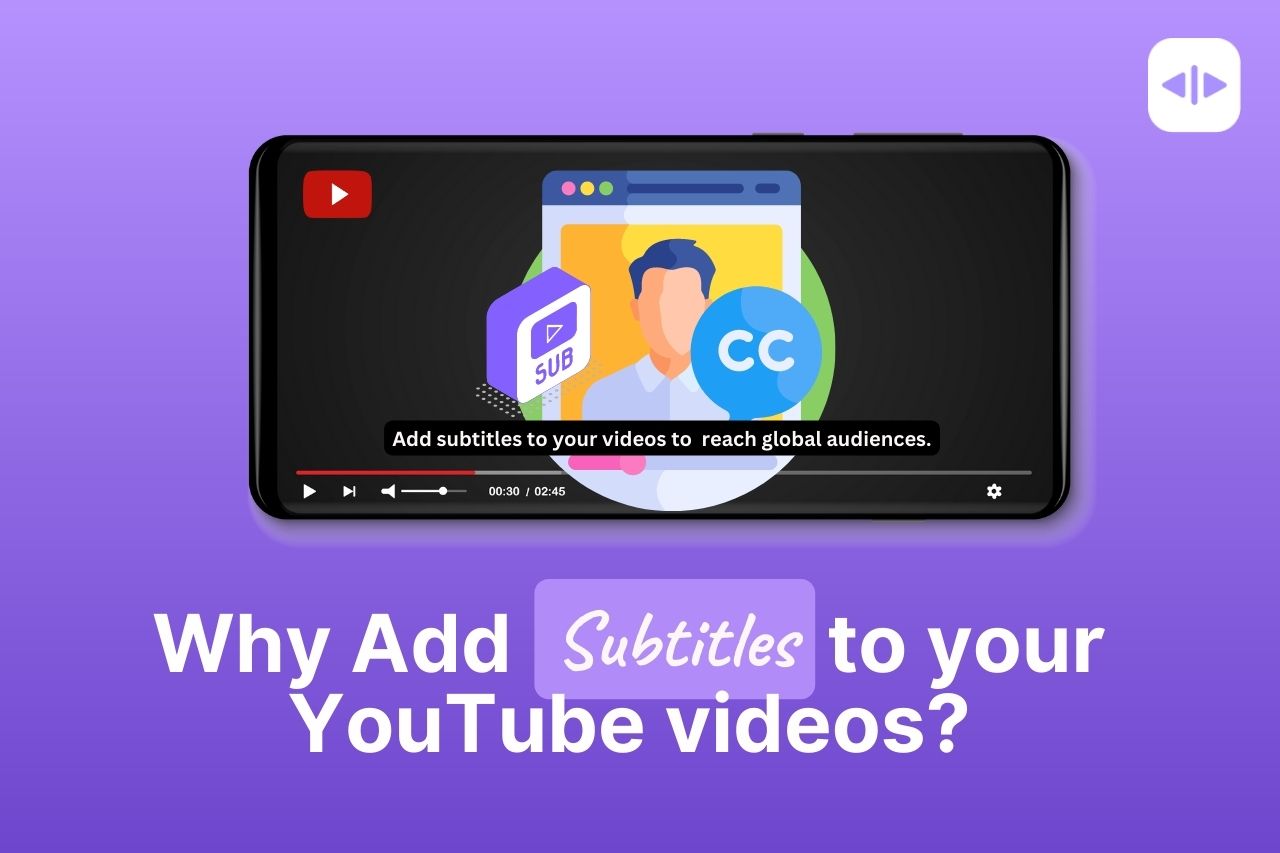Every second counts on YouTube and captivating your audience is the ultimate challenge. As a dedicated content creator, you pour your heart and soul into crafting visually stunning videos that make an impact. But amidst the hustle and bustle, there’s a hidden gem that holds the power to take your YouTube game to the next level—subtitles.
Did you know that 80% of YouTube viewers watch videos on mute? Add subtitles to enhance your video’s accessibility and reach a broader audience.
In this blog, we will delve into the undeniable importance of adding subtitles to your YouTube videos. Beyond mere words on the screen, subtitles hold the key to boosting engagement, expanding your viewer base, and improving overall comprehension.
Read on to explore the benefits of incorporating subtitles and learn how this simple addition can elevate your YouTube channel to new heights.
History of Subtitles on YouTube
Interestingly, subtitles were not always an accessible feature on YouTube. However, with advancements in technology and growing demand for accessibility, YouTube introduced the subtitles feature for videos in 2008. Since then, subtitles have become a vital component of YouTube videos, providing equal access to content for all viewers.
Overall, the accessibility advantages of subtitles in YouTube videos are undeniable. Not only do they provide greater access to content for differently-abled individuals, but they also enhance the viewing experience for all audiences.
By incorporating subtitles, video creators can reach a more extensive and diverse audience and improve the overall accessibility of their content.
Some reasons why adding subtitles to YouTube videos is important are:
- Subtitles help people consume videos in noisy environments.
- They help international audiences easily understand videos in their native language.
- Subtitles assist in keeping viewers engaged.
- Subtitles entice a wider audience by making videos easily searchable, and attract better engagement from viewers.
Almost 80% of viewers prefer subtitles while watching videos.
Accessibility advantages of subtitles
Adding subtitles to YouTube videos provides significant advantages in terms of accessibility.
Accessibility for the Deaf and Non-Native Speakers
Over 5% of the world’s population — or 430 million people — suffer from hearing loss.And this number is projected to reach nearly 2.5 billion by 2050, , making subtitles necessary for accessibility. Subtitles increase the viewing experience for individuals who are deaf or hard of hearing, allowing them to enjoy the content like everyone else. Moreover, subtitles enable non-native speakers to understand the spoken language, improving language accessibility.
SEO Benefits for Video Creators

In addition to accessibility, subtitles benefit video creators by improving search engine optimization (SEO) and increasing the visibility of their content. YouTube’s algorithm recognizes subtitles as metadata, which significantly improves a video’s reach.
Enhanced Viewing Experience
Subtitles enhance the viewing experience by highlighting spoken words and showing them on screen in real-time, complementing the video content. Subtitles allow viewers to watch videos in noisy or crowded environments, where sound quality is compromised. Subtitles can also be translated into multiple languages, making videos accessible to a global audience.
Additionally, creating videos with subtitles helps you stand out as a content creator who is aware of the struggles of different individuals in the audience. Such thoughtfulness and inclusivity boosts a creator’s reputation and viewer loyalty.
Subtitling vs. Closed Captioning: Which One to Choose?
Subtitling and closed captioning are two different ways of adding text on videos that can enhance the viewer’s experience and increase accessibility. Here are six points to consider when deciding between the two:
- Subtitles only display the spoken dialogue and translate it into another language, while closed captions include not only dialogue but also sound effects, music, and other relevant audio cues.
- Subtitles are typically displayed at the bottom of the screen, while closed captions can be positioned anywhere on the video.
- Subtitles are mostly used for foreign language translations or to help viewers understand accents and unfamiliar terms, while closed captions benefit not only people with hearing impairments but also those who watch videos in noisy environments or without sound.
- Subtitles can be created manually or automatically, while closed captions need to comply with specific technical requirements and standards to be accurately recognized by assistive technologies.
- Subtitles are more suitable for all kinds of videos and snippets that can be easily translated, while closed captions work best for longer videos that require more comprehensive audio descriptions.
- Subtitles can be turned off or on by the viewer, while closed captions need to be activated through the video platform’s settings.
In addition to these differences, it’s worth noting that closed captions can be more costly and time-consuming to produce than subtitles, especially if the video has complex or technical content.
How to add subtitles to YouTube videos?
Adding subtitles to YouTube videos is an essential part of video optimization. Let’s explore how to generate subtitles and add them to your YouTube videos:
You can generate subtitles yourself or hire a professional but it can be time-consuming. You will have to wait for at least 24 hours before your video gets accurate, time stamped subtitles. The most effective way is to use AI tools.
Dubverse SUB generates accurate subtitles for any language within minutes so you can upload your videos with subtitles.
Getting started is effortless; creators can quickly sign up for an account and access the intuitive interface. Once logged in, users can easily upload their videos to the Dubverse platform, where the powerful subtitle generator comes into play.
Step 1: Go to Dubverse SUB.
Step 2: Upload your video.
Step 3: Select the languages you want subtitles for. (You can add up to 4 languages at one go)
And Hit “Let’s SUB”!
It’s that easy!
You can use the best subtitles editor to edit your subtitles before publishing them to the Youtube Studio.
Here is how to upload subtitles on your YouTube channel:
If you used Dubverse SUB to generate subtitles, you will find a YouTube Studio button on the output page.
Click on this button to go directly to the subtitles upload page on your YouTube Studio for your channel and add subtitles to your videos without any hassle.
Otherwise,
- Sign in to your YouTube account and go to your Video Manager.
- Select the video you want to add subtitles to and click on the “Edit” button.
- Click on the “Subtitles and CC” tab and select the language you want to add subtitles in.
- Enter your subtitles in the provided text box and click “Publish”.
Improve viewer experience with subtitles!
Nowadays, adding subtitles to videos has become a necessity rather than an optional feature for online content creators, including those who upload their videos to YouTube. Creating a seamless user experience with the right content accessibility helps brands optimize their videos for a wider audience, which can lead to better overall outcomes. There are also countless studies that support this data, citing an average of 7.32% increase in views and watch time when subtitles are added. When it comes to YouTube and online content creation, accessibility is key, and the benefits of adding subtitles extend beyond mere convenience or ‘keeping up with the times’.
FAQs about Benefits Of Adding Subtitles To Youtube Videos
Why should I add subtitles to my YouTube videos?
Adding subtitles to your YouTube videos can make them more accessible to a wider audience, including those who are hearing-impaired or don’t speak your language. Subtitles can also make your videos more searchable and watchable. With professional translators, you can ensure accurate translations, which can help your videos reach a global audience.
How can I add subtitles to my YouTube videos?
You can add subtitles to your YouTube videos using the Video Manager tool on your YouTube account. You can also use third-party AI subtitle tool, Dubverse SUB to generate time-stamped subtitles within minutes. Alternatively, you can use manual professional subtitling services; however they are more time-consuming and expensive.
Can I customize the font, color, and position of my subtitles?
Yes, with subtitles, you have more control over customization options such as font, color, and position, making your subtitles match your brand identity. On the other hand, closed captions are typically white and cannot be customized.
What is the difference between closed captions and subtitles?
Closed captions are the written version of the audio track for a video, including descriptions of sounds. Close captions can only be viewed in the language of the audio. Subtitling, on the other hand, refers to the translation of captions into another language different than the audio. Subtitles can be translated into multiple languages, helping you reach a global audience.
Can Dubverse help me add subtitles to my YouTube videos?
Yes, Dubverse’s SUB can generate AI subtitles for you in over 30 Indian and global languages, using advanced algorithms. Simply upload your video, select your desired languages, and hit “Let’s SUB”. We’ll take care of the rest.



